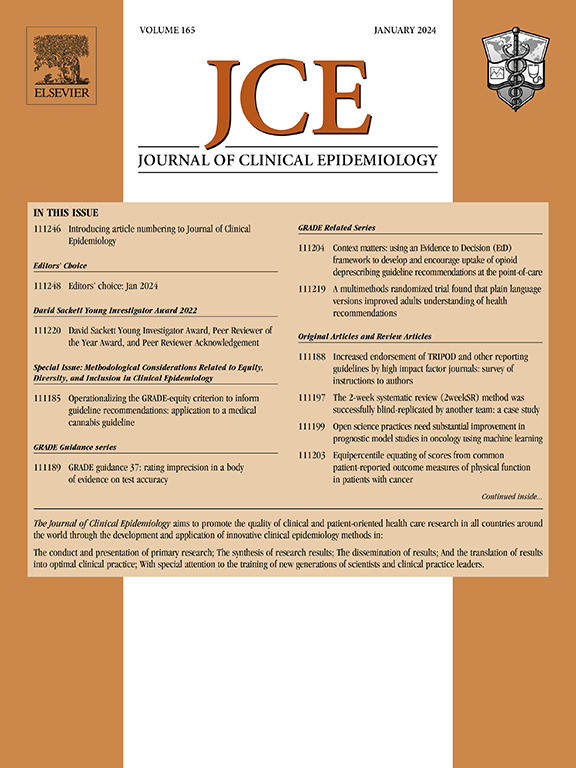Improving the reporting and use of trial results in clinical trials registries: global practices, barriers, and recommendations
IF 5.2
2区 医学
Q1 HEALTH CARE SCIENCES & SERVICES
引用次数: 0
Abstract
Background and Objectives
Recent initiatives promoted results reporting on clinical trials registries to improve transparency and reduce publication bias. However, local reports suggest that results reporting on registries is often inadequate, limiting their usefulness for evidence synthesis. We aimed to 1) provide an overview of results reporting practices across clinical trials registries globally, 2) identify barriers and facilitators to reporting and using results from trials registries, and 3) develop recommendations to improve reporting and usability of results in trials registries.
Study Design and Setting
Three-part mixed methods study. Part 1: Descriptive analysis of results reporting practices for randomized controlled trials (RCTs) starting between 2010 and 2022 across six trials registries (one from each World Health Organization region), with an in-depth analysis focusing on reporting formats and accessibility. Part 2: Two separate online surveys targeting trial registrants and evidence users. Part 3: Discussion among author group to generate recommendations.
Results
Part 1: Our sample included 201,265 RCTs, with 17% (33,163 trials) reporting some form of results on a registry. A subset showed 63% of posted results accessible in the registry record, with 64% to 98% of results data available in a reusable format. Part 2: 86% (194/225) of registrants were aware of registry results reporting possibilities, but time, effort, and fear of publishing interference were barriers. For evidence users, 51% (36/70) had used registry results, with barriers including mistrust of non–peer-reviewed data and difficulty locating results. Part 3: Recommendations include standardizing registry interfaces, addressing misconceptions, and fostering trust in registry-reported results.
Conclusion
Results reporting practices on registries are increasing. Improving these requires better infrastructure, policies, training, and funding. With adequate support, registries can become essential for transparent and efficient evidence dissemination, enhancing research quality, and reducing duplication.
Plain Language Summary
Clinical trials registries are online databases where researchers register medical studies and share their status, details, and results. These registries exist globally and allow researchers to track ongoing studies and emerging evidence on a topic. They also enable the public to identify trials they may be interested to participate in. Although regulations require researchers to share study results on registries within a year of study completion, only a fraction of results are currently available. Our project 1) evaluated the reporting of study results across different trials registries, 2) surveyed individuals involved in reporting and using study findings from registries, and 3) developed recommendations to improve availability and usefulness of these results. We found that increasing trust in registry-reported results, improving registry systems (ie, interfaces, processes), and providing better guidance are necessary steps to enhance reporting and use of registry results. Implementing these changes will make it easier to verify study findings, provide accurate guidelines to physicians, and improve patient care.
改进临床试验注册中试验结果的报告和使用:全球实践、障碍和建议。
背景和目的:最近的举措促进了临床试验注册的结果报告,以提高透明度和减少发表偏倚。然而,地方报告表明,关于登记的结果报告往往不充分,限制了它们对证据综合的有用性。我们的目标是i)概述全球临床试验注册中心的结果报告实践,ii)确定报告和使用试验注册中心结果的障碍和促进因素,以及iii)提出建议,以改善试验注册中心结果的报告和可用性。研究设计与设置:三部分混合方法研究。第1部分:对2010年至2022年期间在六个试验注册中心(每个世卫组织区域一个)开展的随机对照试验(rct)结果报告实践进行描述性分析,重点对报告格式和可及性进行深入分析。第二部分:针对试验注册者和证据使用者的两个单独的在线调查。第3部分:作者小组之间的讨论以生成建议。第一部分:我们的样本包括201,265个随机对照试验,其中17%(33,163个试验)在注册中心报告了某种形式的结果。一个子集显示,在注册表记录中可以访问63%的发布结果,其中64%到98%的结果数据以可重用格式提供。第2部分:86%(194/225)的注册者意识到注册结果报告的可能性,但时间、精力和对发布干扰的恐惧是障碍。对于证据使用者,51%(36/70)使用了注册结果,障碍包括对非同行评审数据的不信任和难以定位结果。第3部分:建议包括标准化注册表接口、解决误解和培养对注册表报告结果的信任。结论:注册中心的结果报告实践正在增加。改善这些需要更好的基础设施、政策、培训和资金。有了充分的支持,登记可以成为透明和有效的证据传播、提高研究质量和减少重复的关键。简单的语言总结:临床试验注册是在线数据库,研究人员在其中注册医学研究并分享其状态、细节和结果。这些登记处遍布全球,使研究人员能够跟踪正在进行的研究和关于某个主题的新证据。它们还使公众能够确定他们可能感兴趣参与的试验。尽管法规要求研究人员在研究完成后的一年内在登记处分享研究结果,但目前只有一小部分结果是可用的。我们的项目1)评估了不同试验注册中心的研究结果报告,2)调查了参与报告和使用注册中心研究结果的个人,3)提出了提高这些结果的可用性和有用性的建议。我们发现增加对注册中心报告结果的信任、改进注册中心系统(即接口、过程)以及提供更好的指导是增强注册中心报告和使用结果的必要步骤。实施这些变化将使验证研究结果更容易,为医生提供准确的指导,并改善患者护理。
本文章由计算机程序翻译,如有差异,请以英文原文为准。
求助全文
约1分钟内获得全文
求助全文
来源期刊

Journal of Clinical Epidemiology
医学-公共卫生、环境卫生与职业卫生
CiteScore
12.00
自引率
6.90%
发文量
320
审稿时长
44 days
期刊介绍:
The Journal of Clinical Epidemiology strives to enhance the quality of clinical and patient-oriented healthcare research by advancing and applying innovative methods in conducting, presenting, synthesizing, disseminating, and translating research results into optimal clinical practice. Special emphasis is placed on training new generations of scientists and clinical practice leaders.
 求助内容:
求助内容: 应助结果提醒方式:
应助结果提醒方式:


